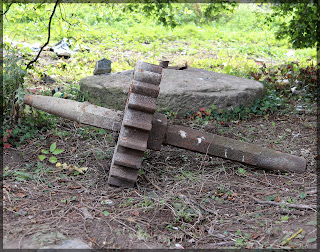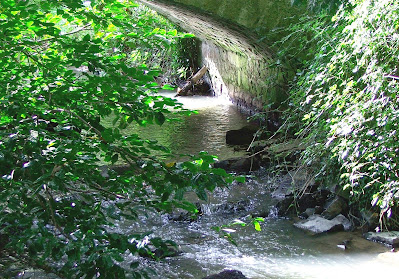The Gunpowder mills.
There have been many mills established along the Camac river at Clondalkin over the centuries but one of the largest was the Gunpowder Mills at Corkagh. This section of the Corkagh estate is known as Kilmatead but officially the townland name is Corkagh and the townland name of the adjacent park is Corkagh Demesne! Most of the 'powder mills' complex lies outside of the park boundary, however a mill pond, mill race, and mill building are located at the south western side of the fishing lakes.
 |
| 18th century millpond near the fishing lakes |
In 1703, Lewis Chaigneau a successful merchant from a French Huguenot family purchased a large parcel of land near Clondalkin which went on to form the basis of the Corkagh estate. Lewis had links to another successful Huguenot family, the Gruebers, who operated
gunpowder mills in England. He parcelled off the southwestern section of the estate to be leased to them for the establishment of a mill. Building commenced in 1716 and additional mill buildings were added over the following decades. Part of the annual rent payable to owners of Corkagh included a quantity of gunpowder!
The land surrounding the Camac at Corkagh had been considered too waterlogged to be farmed profitably and so had naturally reverted to Hazel and Alder woodland. These trees, for a while, provided the charcoal that is such an important ingredient in the manufacture of gunpowder.
Today one of the mill ponds can be easily seen next to the fishing lakes. This pond is fed by water from the Fettercairn Stream which runs under the Naas Road and through Kilmatead. Next to the pond, behind the hedge, a mill race which fed water to the wheel can still be seen as can the ruined mill building behind it.
Please approach this area with caution, there is a steep drop into fast flowing water.
 |
| This photo of the mill race was taken from the ruined mill building. |
The ruined mill building can be accessed safely from the other side of the mill race but be careful of briars and nettles
 |
| Inside the ruins of mill building at Corkagh |
Past the millrace the water flows a short distance before being briefly diverted along an underground tunnel to emerge again behind the 'Fairy Woods'. This tunnel was tall enough to allow local children to walk through it in times past.
In the 18th century an immense explosion blew the foundations of a gunpowder mill at Clondalkin into surrounding fields. The blast was felt as far away as the city centre where one building
lost a chimney as a result. The medieval church (in the grounds of the present Protestant Church) at Clondalkin village, already ruinous, was further damaged by the blast however the Round Tower stood firm. It is possible that this explosion occurred at Corkagh but more likely that it was Mr Caldbecks (he lived at Moyle Park) mill which was located near Clondalkin village.
After the gunpowder mills ceased operations in 1815 Kilmatead was returned to the Finlay family of Corkagh Demesne. The complex not only included mill buildings but also a fine house (known as Little Corkagh),
outbuildings and walled gardens.
During the 19th century the Finlay/Colley family occasionally rented out Corkagh House and lived at Kilmatead or vice versa. However the mill next to the fishing lakes continued to function having been converted for 'thrashing and cleaning' and indeed there is an account that the mill wheel was still being used in the 1940s. When the Colley family sold Corkagh in 1959 they retained the lands at Kilmatead and still live there today.
What we can see from Corkagh is only a fraction of the mill complex. The main entrance was from the Naas Road and is still visible as the access road to Wilsons Auctions on the Naas/GreenIsle Road.
Kilmatead had its own gate lodge at the entrance with a small quarry next to it but all traces have disappeared due to road construction.
However, behind Wilsons, surrounded by mature trees, Kilmatead remains a haven of peace. A large mill pond (possibly the first to be built) still exists just behind Wilsons. It is fed by the waters of the Fettercairn Stream which flows from Belgard to join the Camac at Kilmatead. The noisy mill works have long ceased and the remaining buildings have been refurbished as residential units.
Short video taken at the ruins of a late 18th c mill near the fishing lakes
All images and videos copyright of the author













